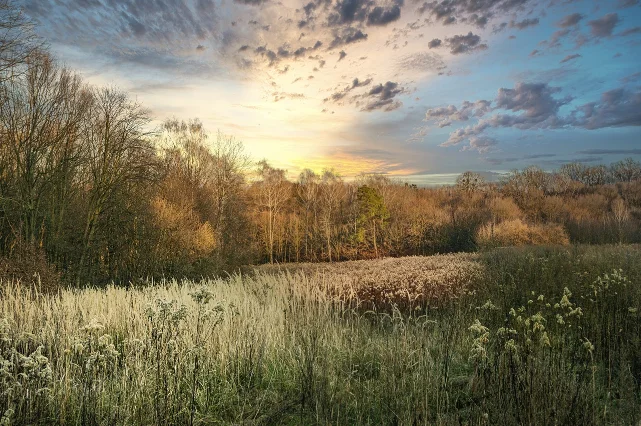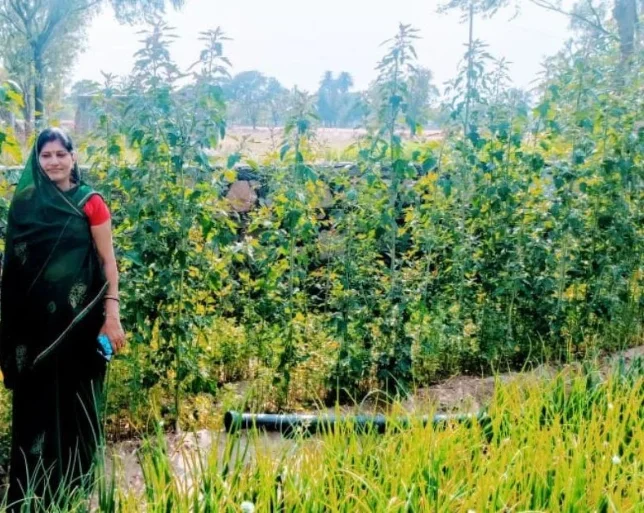The Forest First Samithi has embarked on a transformative journey to revitalize the land. They’re focused on preserving biodiversity, reforesting with 100 native tree species from the Western Ghats, restoring the natural balance, collecting rainwater, and rehabilitating a previously degraded area overrun by Lantana plants.
In the region of Wayanad situated within the Western Ghats, where the Kabini River flows as a major tributary of the Cauvery River, a concerning trend is unfolding. The unique native trees of this area are disappearing rapidly both within the forests and in the surrounding areas. Around 40% of the forested land has been replaced by teak, eucalyptus, or silver oak plantations. This transformation of the landscape has had a profound impact—vital indigenous trees of the Western Ghats have been cut down, affecting the diverse plant life, soil quality, water retention, and the perennial flow of streams.
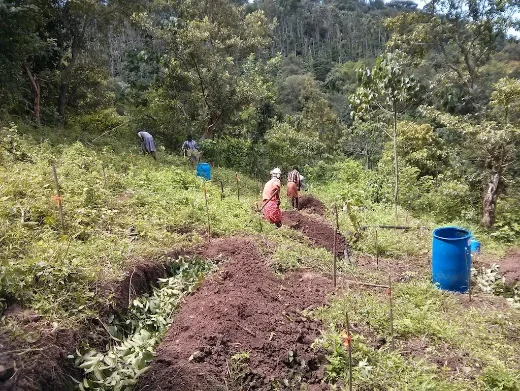
Preserving the native trees from the Western Ghats in this landscape has become not just an option, but the only viable path forward. It’s crucial for maintaining the rich variety of plants that play a pivotal role in ensuring our food and water security.
The journey on a relatively small 8-acre plot of land showcases a range of choices available to farmers in the area. One of these options involves setting aside 10% of their land for creating “farm groves,” following the example set by Forest First Samithi.
Farm Groves: Combining Farming and Forest Groves in Harmony
Back in 2008, when we acquired a worn-out piece of land spanning 8 acres, with just about 10 trees left, our mission was crystal clear: reforest the area. Our goal was to let a section of the land return to a natural forest state, promoting biodiversity.
This land had quite the challenge. It had steep slopes with angles of about 45 degrees and was nestled between two hills. Before we began the process of reforestation, the land experienced significant soil erosion during heavy monsoons. The farm faced the southwest and the strong sun rays would bake the soil in summer. These tough conditions, with minimal shade and extreme exposure to rain and sunlight, resulted in two problems: the invasive weed known as Lantana proliferated, and the topsoil was washed away during monsoons. Dealing with Lantana required spending Rs. 30,000 annually. During heavy rainfall, the topsoil would be carried away, leading to the unsettling sight of red-tinted water streaming from the land.
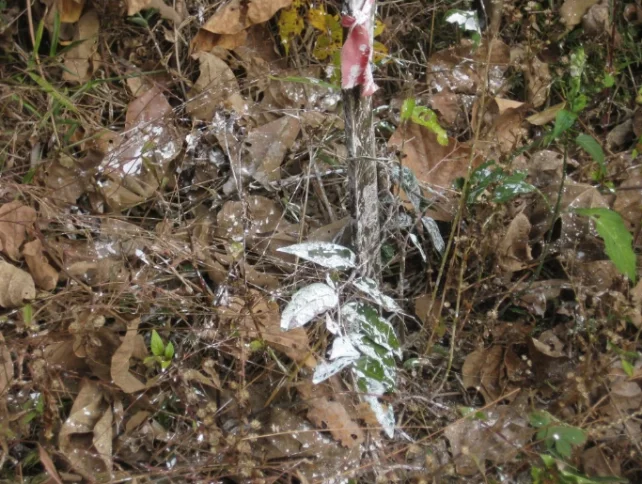
The solution was evident – we needed shade, more organic matter, and a way to anchor the topsoil – and trees were the natural answer.
Located on the eastern side of Wayanad, on the slopes of the Western Ghats, our farm was witnessing a rapid decline in the native tree species specific to the Western Ghats. The neighboring farms were dominated by a single type of non-native tree, the silver oak, and every summer, the landscape lost its original trees to the demand for timber.
The disheartening noise of chainsaws would echo through Wayanad during April and May. Truckloads of trees were being felled. It became clear that we had to preserve a collection of native Western Ghats tree species for future generations.
Exploring Native Tree Varieties
The team at Forest First Samithi delved into various research reports about the trees native to their area. Their task was to get their hands on these special tree species. Their hunt led them to discover several nurseries and organizations dedicated to safeguarding these trees. They kicked off their planting efforts in 2009 and continued for five years until 2014, successfully preserving more than 100 tree species. This impressive collection included many types that are rare, endangered, or at risk in the Western Ghats region. Over the years, they managed to achieve survival rates ranging from 60% to an impressive 90% for the saplings they planted.
Also Read: Farmer makes 5 lakh rupees per acre using Sustainable Intercropping technique
The change in the land’s condition
After eight years of dedicated work, an incredible transformation had taken place on the land. With care and effort, they managed to plant over 3,000 saplings from more than 100 different species on their 8-acre plot. They achieved this remarkable feat using smart techniques.
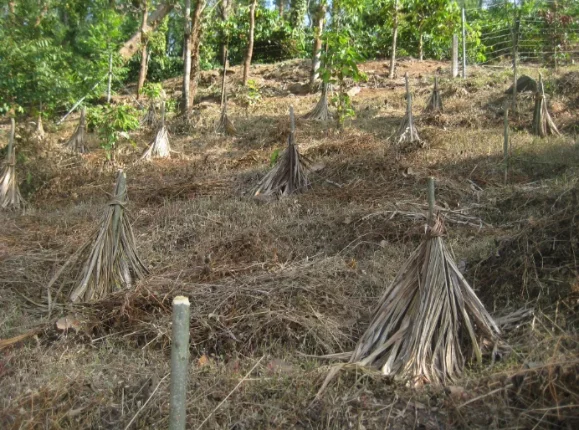
Within three years, they effectively got rid of the invasive Lantana weed through two clever methods. They planted gliricedia, which provided biomass, and bananas as intercrops, creating much-needed shade for the young plants to thrive, especially during the harsh summer months. This approach not only helped the saplings but also provided some economic benefit by allowing the cultivation of bananas, which sustained two women working on the farm.
Around 2012-13, they dug rainwater trenches along the land’s contours and planted gliricedia on the bunds. This move was crucial for proper water absorption in the area and for enhancing the local climate. On steeper slopes, vetriver was planted to prevent soil erosion.
They changed their approach to managing the space around the coffee plants. Instead of completely clearing the biomass, they adopted a method called “chop and drop,” which involved cutting down unwanted plants without disturbing the soil and roots. This helped retain soil integrity.
The introduction of two native cows to the farm had an unexpected benefit. These cows produced manure that was used to make jeevamrita, a natural fertilizer. Applying this regularly on the land, especially in the rainwater trenches, helped the intercropped coffee, pepper, lemon, oranges, and bananas thrive.
The team planted various Ficus species, which attracted a diverse range of birds. To encourage pollinators like butterflies, they strategically planted host plants. The stumps of the trees and gliricedia plants attracted owlets, which acted as natural pest controllers. The presence of Ficus trees also led to an increase in the bat population. The land became a bustling hotspot for birds, frogs, butterflies, bats, and even snakes, all coexisting alongside the numerous tree species.

One surprising development after seven years of hard work was the appearance of leeches during the monsoon season. This signaled a positive change in the land’s moisture retention ability, and the rainwater no longer had a reddish tint. The soil’s biomass improved thanks to the fast-growing trees’ fallen leaves. The team was thrilled to witness the remarkable process of land transformation they had achieved through their efforts.
Eco Services
Their fellow farmers raised eyebrows at their decision to plant forest trees. Many advised against planting Ficus trees on their farmland. These were well-meaning and experienced neighbors who knew that decades of chemical farming had shifted local farmers away from traditional practices. So, the pair did their best to absorb their wisdom, blending it with their own understanding of natural farming and permaculture.
The forested area at the highest point of their land serves as an excellent water holder, a source of organic material, a sanctuary for predators that help control pests, and a home for pollinators that benefit the land. And all these advantages come without any ongoing expenses.
Infinite potential
In farming, there are many ways to combine tree species with different aspects. For instance, pepper can be a great crop to grow alongside trees that provide shade. You can also plant tubers in areas where young trees are growing, protecting them from wild boar attacks. Certain herbs that are valued in Ayurveda for their economic benefits can be grown as intercrops alongside tree saplings. Intercropping banana plants with trees not only adds to the landscape but also creates a cooler microclimate that helps the native saplings grow well. And some tree species are valuable for reasons other than their wood, like the triphala species which includes Terminalia chebula (Haritaki), Terminalia bellirica (Bahera), and Emblica officinalis (Amla).
Making money from these practices doesn’t solely depend on wood. We should view these mixed groves for the services they offer to the environment. Every farm can allocate around 10% of its total area to support these environmental services. It’s crucial to extend efforts to conserve forest trees beyond just forest boundaries. Policy changes should encourage and support the preservation of these mixed groves within farms, as they play a vital role in ensuring the nation’s food security.
About Forest First Samithi
Forest First Samithi is a registered group dedicated to safeguarding the unique trees of the Western Ghats and promoting diverse species. They’ve transformed parts of various farms into special areas called farm groves. Currently, they’re also working on a 60-acre piece of land within a place called Kodagu.
The Forest First Samithi family started with just four passionate individuals who aimed to protect biodiversity. Now, their family has grown to include 10 core members and nearly 30 volunteers. They’ve successfully nurtured around 5,000 native trees, and their space is shared with a bunch of intriguing animals – there’s a naati cow named Parvathy, a bull named Shankar, along with peacocks, barking deer, wild boars, rabbits, numerous birds, frogs, bats, butterflies, and even some leeches. Every day, this family of nature enthusiasts keeps expanding.
If you’re excited about joining this journey, you can get in touch by sending an email to forestfirstsamithi@gmail.com or http://www.forestfirstsamithi.org/ https://www.facebook.com/forestfirstsamithi?fref=photo


